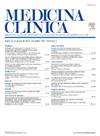应用深度学习定量分析胸部CT评价托法替尼治疗抗mda5 +皮肌炎的疗效
IF 2.1
4区 医学
Q1 MEDICINE, GENERAL & INTERNAL
引用次数: 0
摘要
本研究旨在阐明定量高分辨率计算机断层扫描(HRCT)分析是否可以评估与抗黑色素瘤分化相关基因5阳性(抗MDA5+)皮肌炎(DM)相关的间质性肺疾病(ILD)的病情,并探讨托法替尼治疗抗MDA5+ DM的疗效。材料和方法本研究纳入70例患者。托法替尼组39例,非托法替尼组31例。将患者的HRCT上传到深度学习系统以评估ILD的消退。根据患者HRCT定量结果、生存率及糖皮质激素(GCs)使用情况,评估托法替尼治疗抗mda5 + DM的疗效。通过记录不良反应发生率来评估安全性。采用SPSS26.0和R4.4.1对数据进行分析。结果除皮肤受累外,两组患者的基线特征无显著差异。托法替尼组3年生存率较高,是预防死亡的独立保护因素。血清铁蛋白升高(>1000 μg/L)增加死亡风险。定量HRCT分析显示,在基线和随访期间,托法替尼组全肺受累百分比显著降低。托法替尼组治疗后全肺病灶体积的减少明显更高。托法替尼组GCs逐渐减少的持续时间较短,EBV感染的风险较高。结论定量HRCT分析可用于评估ILD对托法替尼治疗的反应。托法替尼对抗mda5 + DM-ILD患者有效,但会增加感染风险。本文章由计算机程序翻译,如有差异,请以英文原文为准。
Quantitative analysis of chest CT with deep learning to assess the efficacy of tofacitinib in the treatment of anti-MDA5+ dermatomyositis
Introduction and objectives
This study aimed to clarify whether quantitative high-resolution computed tomography (HRCT) analysis can assess the condition of interstitial lung disease (ILD) associated with anti-melanoma differentiation-associated gene 5 positive (anti MDA5+) dermatomyositis (DM) and investigate the efficacy of tofacitinib in the treatment of anti-MDA5+ DM.
Materials and methods
Seventy patients were included in this retrospective study: 39 in the tofacitinib group and 31 in the group without tofacitinib. Patients’ HRCT were uploaded to a deep learning system to assess ILD regression. Based on patients’ quantitative HRCT results, survival and glucocorticoids (GCs) usage, the efficacy of tofacitinib in the treatment of anti-MDA5+ DM were assessed. The safety was assessed by recording the incidence of adverse reactions. Data were analyzed using SPSS26.0 and R4.4.1.
Results
No significant differences for baseline characteristics were observed between the two groups of patients, except for cutaneous involvement. Tofacitinib group showed higher 3-year survival and it was an independent protective factor against mortality. Elevated serum ferritin (>1000 μg/L) increased the risk of death. Quantitative HRCT analysis showed a significant reduction in the percentage of whole-lung involvement in the tofacitinib group between the baseline and follow-up. The total lesion volume reduction in the whole lung after treatment was substantially higher in the tofacitinib group. The tofacitinib group had a shorter duration of GCs tapering and a higher risk of EBV infection.
Conclusions
Quantitative HRCT analysis can be used to assess the response of ILD to tofacitinib treatment. Tofacitinib is effective in patients with anti-MDA5+ DM-ILD but increases the risk of infection.
求助全文
通过发布文献求助,成功后即可免费获取论文全文。
去求助
来源期刊

Medicina Clinica
医学-医学:内科
CiteScore
3.10
自引率
5.10%
发文量
295
审稿时长
22 days
期刊介绍:
Medicina Clínica, fundada en 1943, es una publicación quincenal dedicada a la promoción de la investigación y de la práctica clínica entre los especialistas de la medicina interna, así como otras especialidades. Son características fundamentales de esta publicación el rigor científico y metodológico de sus artículos, la actualidad de los temas y, sobre todo, su sentido práctico, buscando siempre que la información sea de la mayor utilidad en la práctica clínica.
 求助内容:
求助内容: 应助结果提醒方式:
应助结果提醒方式:


